Of the many traditions associated with the celebration of Thanksgiving in the U.S., the most commonly mentioned one is the ritual consumption of an avian theropod, Meleagris gallopavo, simply known by most people as “turkey.” The majority of turkeys that people will eat this Thursday, and for much of the week afterwards, are domestically raised. Yet these birds are all descended from wild turkeys native to North America. This is in contrast to chickens (Gallus gallus), which are descended from an Asian species, and various European mammals, such as cattle, pigs, sheep, and goats (Bos taurus, Sus scrofa, Ovis aries, and Capra aegagrus, respectively).
 Trackway of a wild turkey (Meleagris gallopavo) crossing a coastal dune on Cumberland Island, Georgia. Notice how this one, which was likely a big male (“tom”), was meandering between clumps of vegetation and staying in slightly lower areas, its behavior influenced by the landscape. Scale = 20 cm (8 in). (Photograph by Anthony Martin.)
Trackway of a wild turkey (Meleagris gallopavo) crossing a coastal dune on Cumberland Island, Georgia. Notice how this one, which was likely a big male (“tom”), was meandering between clumps of vegetation and staying in slightly lower areas, its behavior influenced by the landscape. Scale = 20 cm (8 in). (Photograph by Anthony Martin.)
American schoolchildren are also sometimes taught that one of the founding fathers of the United States, Benjamin Franklin, even suggested that the wild turkey should be elevated to the status of the national bird, in favor of the bald eagle (Haliaeetus leucocephalus). With an admiring (although I suspect somewhat facetious) tone, he said:
“He [the turkey] is besides, though a little vain & silly, a Bird of Courage, and would not hesitate to attack a Grenadier of the British Guards who should presume to invade his Farm Yard with a red Coat on.”
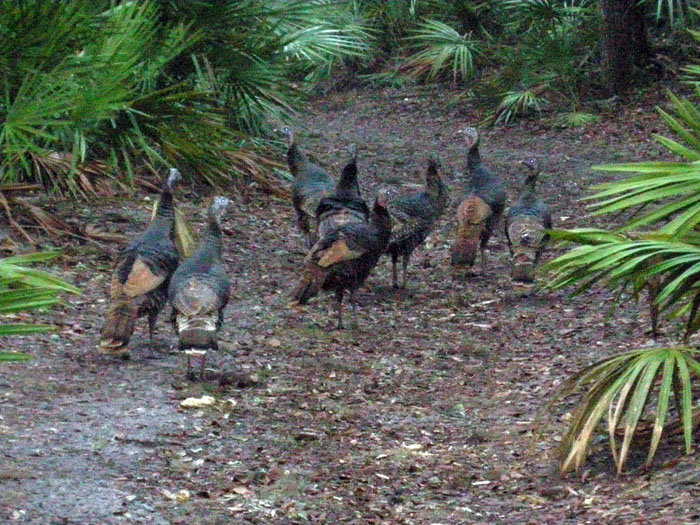 There are eight of us, and only one of you. Do you really want to mess with us? (Photograph by Anthony Martin, taken on Cumberland Island, Georgia.)
There are eight of us, and only one of you. Do you really want to mess with us? (Photograph by Anthony Martin, taken on Cumberland Island, Georgia.)
Unfortunately, because I live in the metropolitan Atlanta area, I never see turkeys other than the dead packaged ones in grocery stores. Nonetheless, one of the ways I experience turkeys as wild, living animals is to visit the Georgia barrier islands, and the best way for me to learn about wild turkey behavior is to track them. This is also great fun for me as a paleontologist, as their tracks remind me of those made by small theropod dinosaurs from the Mesozoic Era. And of course, as most schoolchildren can tell you, birds are dinosaurs, which they will state much more confidently than anything they might know about Benjamin Franklin.
Compared to most birds, turkeys are relatively easy to track. Their footprints are about 9.5-13 cm (3.7-5 in) long and slightly wider than long, with three long but thick, padded toes in front and one shorter one in the back, pointing rearward. In between these digits is a roundish impression, imparted by a metatarsal. This is a trait of an incumbent foot, in which a metatarsal registers behind digit III because the rear part of that toe is raised off the ground. The short toe is digit I, equivalent to our big toe, but not so big in this bird. Despite the reduction of this toe, its presence shows that turkeys probably descended from tree-dwelling species, as this toe was used for grasping branches. Clawmarks normally show on the ends of each toe impression, and when a turkey is walking slowly, it drags the claw on its middle toe (digit III), thus making a nicely defined linear groove.
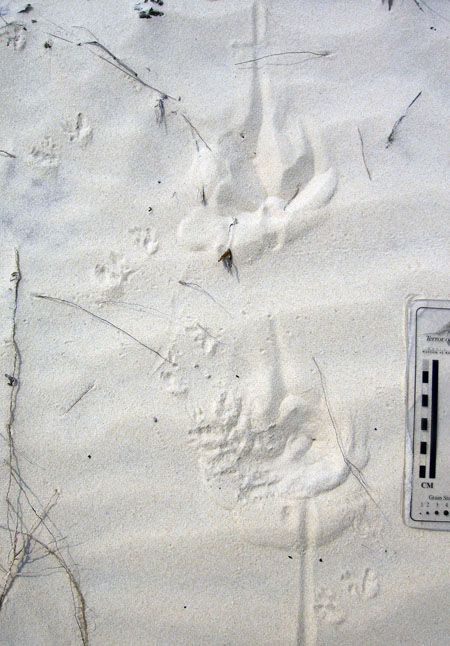 Wild turkey tracks made while it was walking slowly up a gentle dune slope, dragging the claw on the middle digit of its right foot, making a long groove. Also notice the bounding tracks of a southern toad (traveling lower right –> upper left), cross-cutting the turkey tracks. (Photograph by Anthony Martin, taken on Cumberland Island.)
Wild turkey tracks made while it was walking slowly up a gentle dune slope, dragging the claw on the middle digit of its right foot, making a long groove. Also notice the bounding tracks of a southern toad (traveling lower right –> upper left), cross-cutting the turkey tracks. (Photograph by Anthony Martin, taken on Cumberland Island.)
A normal walking pace (right foot –> left foot, left foot –> right foot) for a turkey is anywhere from 15-40 cm (6-16 in), and its stride (right foot –> right foot, left foot –> left foot) is about twice that, or 30-80 cm (12-32 in), depending on the age and size of the turkey. Their trackways show surprisingly narrow straddles for such wide-bodied birds, only 1.5 times more than track widths. This is because they walk almost as if on a tightrope, with angles between each step approaching 180°; so they still make a diagonal pattern, but nearly define a straight line. However, turkeys meander, stop, or change direction often enough to make things interesting when tracking them. Their flocking behavior also means their tracks commonly overlap with one another or cluster, making it tough to pick out the trackways of individual turkeys. However, in such flocks, the dominant male’s tracks are noticeably larger than those of the females or younger turkeys, so these can be picked out and help with sorting who’s who.
 Turkey trackway in which it walked across the wind-rippled surface of a coastal dune on Cumberland Island, meandering while moseying. Same photo scale as before. (Photograph by Anthony Martin.)
Turkey trackway in which it walked across the wind-rippled surface of a coastal dune on Cumberland Island, meandering while moseying. Same photo scale as before. (Photograph by Anthony Martin.)
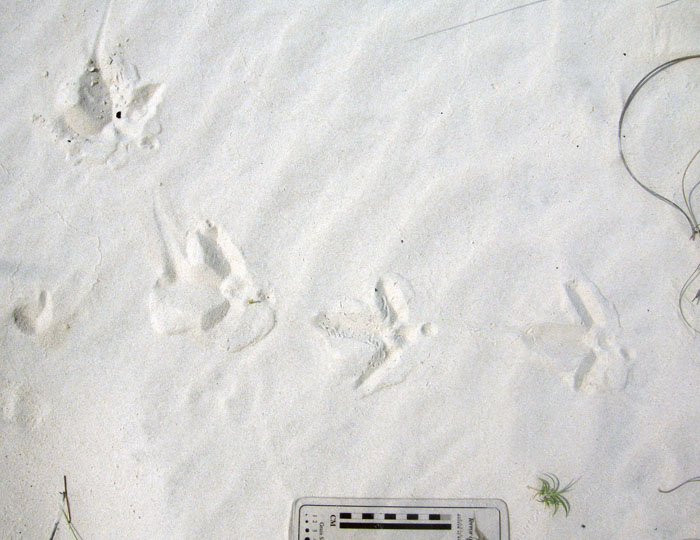 An abrupt right turn recorded by a turkey’s tracks. Check out that beautiful metatarsal impression in the second track from the right, and how the claw dragmark in the thrid track from the right points in the direction of the next track. (Photograph by Anthony Martin.)
An abrupt right turn recorded by a turkey’s tracks. Check out that beautiful metatarsal impression in the second track from the right, and how the claw dragmark in the thrid track from the right points in the direction of the next track. (Photograph by Anthony Martin.)
One of the more remarkable points about these Georgia barrier-island turkeys, though, is how their tracks belie their stereotyped image as forest-only birds. Although they do spend much of their time in the forest, I’ve tracked turkeys through broad swaths of coastal dunes, and sometimes they will stop just short of primary dunes at the beach. So however difficult it might be to think about these birds as marginal-marine vertebrates, their tracks overlap the same places with ghost-crab burrows and shorebird tracks. Geologists and paleontologists take note: this exemplifies the considerable overlap between terrestrial and marginal-marine tracemakers that can happen in coastal environments. This also happened with dinosaurs that strolled onto tidal flats or otherwise passed through marginal-marine ecosystems.
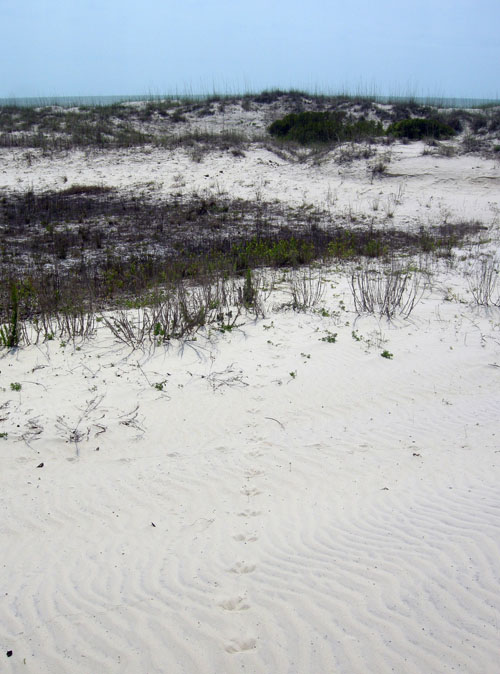 Turkey tracks heading toward the beach, with the open ocean visible just beyond. Is this close enough to consider turkeys as marginal-marine tracemakers? (Photograph by Anthony Martin.)
Turkey tracks heading toward the beach, with the open ocean visible just beyond. Is this close enough to consider turkeys as marginal-marine tracemakers? (Photograph by Anthony Martin.)
Do these turkeys also have an impact on the dunes themselves? Yes, although these effects vary, from trackways disrupting wind ripples to more overt changes to the landscape. For instance, one of the most interesting effects I’ve seen is where they’ve caused small avalanches of sand downslope on dune faces. Interestingly, this same sort of phenomenon was also documented for Early Jurassic dinosaurs that walked across dry sand dunes, which caused grainflows that cascaded downhill with each step onto the sand.
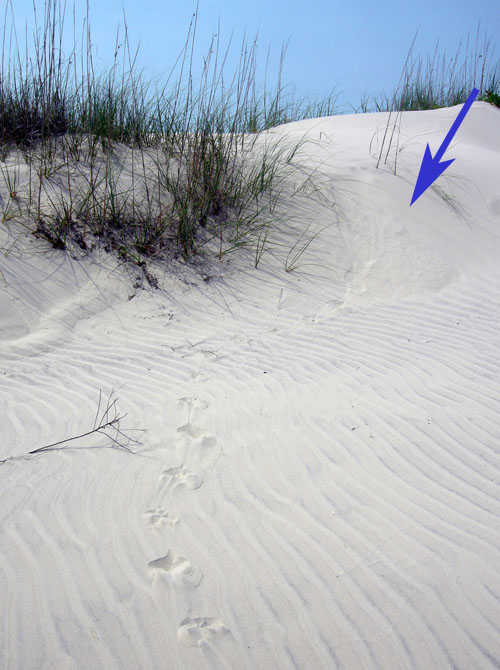 Grainflow structure (arrow), a small avalanche caused by a turkey walking down a dune face. (Photograph by Anthony Martin.)
Grainflow structure (arrow), a small avalanche caused by a turkey walking down a dune face. (Photograph by Anthony Martin.)
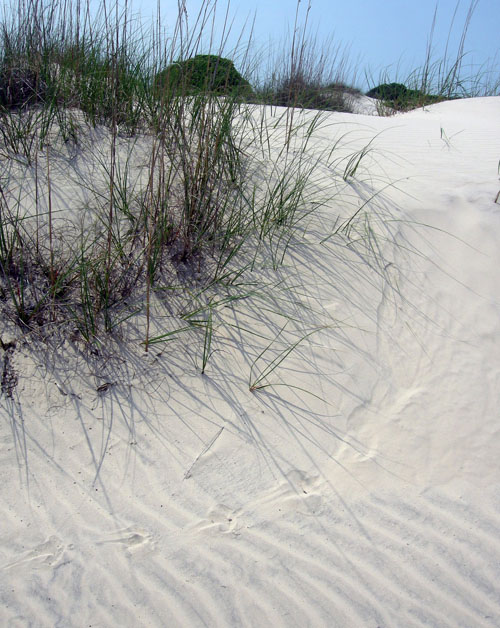 Close-up of grainflow structure (right) connected to turkey tracks, which become better defined once the turkey reached a more level surface. (Photograph by Anthony Martin, taken on Cumberland Island.)
Close-up of grainflow structure (right) connected to turkey tracks, which become better defined once the turkey reached a more level surface. (Photograph by Anthony Martin, taken on Cumberland Island.)
What other traces do turkeys make? A lot, although I’ve only seen their tracks. Other traces include dust baths, feces, and nests. Dust baths, in which turkeys douse themselves with dry sediment to suffocate skin parasites, must be awesome structures. These are described as 50 cm (20 in) wide, 5-15 (1-3 in) deep, semi-circular depressions, and feather impressions show up in those made in finer-grained sediments. Although such structures would have poor preservation potential in the fossil record, I hold out hope that if paleontologists start looking more at modern examples, they are more likely to find a fossil dust bath, whether in Mesozoic or Cenozoic rocks.
Turkey feces, like most droppings from birds, have white caps on one end, but are unusual in that these can tell you the gender of their depositor. Male turkeys tend to make curled cylinders that are about 1 cm wide and as much as 8 cm long (0.4 X 3 in), whereas females make more globular (not gobbular) droppings that are about 1 cm (0.4 in) wide. These distinctive shapes are a result of their having different digestive systems. Turkeys are herbivores, so their scat normally includes plant material, but don’t be surprised to see insects parts in them, too. Still think about how exciting it would be to find a grouping of same-diameter cylindrical and rounded coprolites in the same Mesozoic deposit, yet filled with the same digested material, hinting at gender differences (sexual dimorphism) in the same species of dinosaur maker.
Turkeys normally make nests on the ground by scratching out slight depressions with their feet, but evidently this is a flexible behavior. On at least one of the Georgia barrier islands (Ossabaw), these birds have been documented as building nests in trees. Although this practice seems very odd for a large, ground-dwelling bird, it is an effective strategy against feral hogs, which tend to eat turkey eggs, as well as eggs of nearly every other species of bird or reptile, for that matter. Just to extend this idea to the geologic past, ground nests are documented for several species of dinosaurs, but tree nests are unknown, let alone whether species of ground-nesting dinosaurs were also capable of nesting in trees.
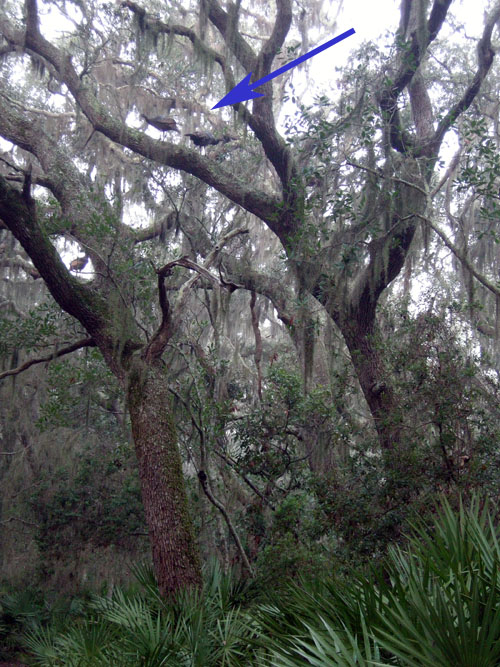 As everyone should know from their favorite WKRP episode, domestic turkeys can’t fly. But wild turkeys can, and use this ability to get into the branches of live oaks (arrow), high above their predators, or even curious ichnologists. (Photograph by Anthony Martin, taken on Cumberland Island.)
As everyone should know from their favorite WKRP episode, domestic turkeys can’t fly. But wild turkeys can, and use this ability to get into the branches of live oaks (arrow), high above their predators, or even curious ichnologists. (Photograph by Anthony Martin, taken on Cumberland Island.)
So whether or not you have tryptophan-fueled dreams while dozing later this week, keep in mind not just the evolutionary heritage of your dinosaurian meal, but also what their traces tell us about this history. Moreover, it is an understanding aided by these magnificent and behaviorally complex birds on the Georgia barrier islands. For this alone, we should be thankful.
![]() Paleontologist Barbie, tracking wild turkeys on the Georgia coast to learn more about how these tracemakers can be used as modern analogs for dinosaur behavior and traces, and once again demonstrating why she is the honey badger of paleontologists. (Yes, photograph by me, and taken on Cumberland Island. P.S. Happy Thanksgiving!)
Paleontologist Barbie, tracking wild turkeys on the Georgia coast to learn more about how these tracemakers can be used as modern analogs for dinosaur behavior and traces, and once again demonstrating why she is the honey badger of paleontologists. (Yes, photograph by me, and taken on Cumberland Island. P.S. Happy Thanksgiving!)
Further Reading
Dickson,J.G. (editor). 1992. Wild Turkeys: Biology and Management. Stackpole Books, Mechanicsburg, Pennsylvania: 463 p.
Elbroch, M., and Marks, E. 2001. Bird Tracks and Sign of North America. Stackpole Books, Mechanicsburg, Pennsylvania: 456 p.
Fletcher, W.O., and Parker, W.A. 1994. Tree nesting by wild turkeys on Ossabaw Island, Georgia. The Wilson Bulletin, 106: 562.
Loope, D.B. 2006. Dry-season tracks in dinosaur-triggered grainflows. Palaios, 21: 132-142.

I will look for these tracks the next time I go to the beach.
Great, Mark! You’re fulfilling one of the main goals of this blog and my book, is to get people to start looking for tracks, trails, burrows, and other signs whenever they visit the Georgia coast.